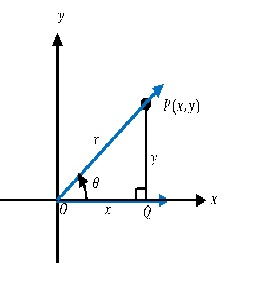Classification of errors in determining trigonometry function values at standard positions
DOI:
https://doi.org/10.23917/jramathedu.v8i2.1625Keywords:
Trigonometry, Conceptual Error, Principle Error, Calculation Error, Factual ErrorAbstract
One of the important materials to study in a trigonometry course is the value of trigonometric functions in standard positions. However, the results of preliminary research show that there are still many first semester students who experience errors in determining the value of the trigonometric function in the standard position. These errors are important for further analysis. Therefore this study aims to describe the mistakes of the first semester students in determining the value of the trigonometric function in the standard position. This type of research is a qualitative descriptive study with a case study approach towards students of the mathematics education study program at a university in Malang. The data collected in this study consisted of the subject's work and transcripts of interviews with the subject. Work data were analyzed descriptively to know the types of student errors. The transcript data from the interview results were analyzed by coding, to determine the factors that caused student error. The results showed that out of 34 students who made errors in determining the value of trigonometric functions at the standard position, 11% had conceptual errors, 56% had principle errors, 15% had calculation errors and 18% had factual errors. The results of this study contribute to teaching the material for the value of trigonometric functions in the standard position to reduce conceptual errors, principle errors, calculatin errors, and factual errors.
References
Abidin, Z. (2012). Analisis Kesalahan Mahasiswa Prodi Pendidikan Matematika Fakultas Tarbiyah IAIN AR-Raniry dalam Mata Kuliah Trigonometri dan Kalkulus 1. Jurnal Ilmiah DIDAKTIKA, 13(1), 183–196.
Awofala, A. O. A., & Odogwu, H. N. (2017). Assessing Preservice Teachers’ Mathematics Cognitive Failures as Related to Mathematics Anxiety and Performance in Undergraduate Calculus. Acta Didactica Napocensia, 10(2), 81–98. https://doi.org/10.24193/adn.10.2.7
Ball, D. (1993). With an Eye on the Mathematical Horizon: Dilemmas of Teaching Elementary School Mathematics. The Elementary School Journal, 93(4), 373–397. https://doi.org/10.1086/461730
Ball, D. L., & Friel, S. N. (1991). Implementing the “professional standards for teaching mathematics”: What’s all this talk about “discourse”? The Arithmetic Teacher, 39(3), 44–48.
Barkai, R. (2021). Using cases as a means to discuss errors in mathematics teacher education. Education Sciences, 11(10). https://doi.org/10.3390/educsci11100575
Borasi, R. (1994). Capitalizing on Errors as “Springboards for Inquiry”: A Teaching Experiment. Journal for Research in Mathematics Education, 25(2), 166. https://doi.org/10.2307/749507
Creswell, J. W. (2012). Educational Research Planning, Conducting and Evaluating Quantitative and Qualitative Research (Fourth). Pearson Education, Inc.
Downing, D. (2009). Dictionary of Mathematics Terms. In Barron’s Educational Series, Inc. (Third Edit). Barron’s Educational Series, Inc. https://doi.org/10.2307/3614426
Gür, H. (2009). Trigonometry Learning. New Horizons in Education, 57(1), 67–80.
Hidayat, W., & Aripin, U. (2020). Identifikasi Kesalahan Jawaban Mahasiswa Pada Mata Kuliah Trigonometri Berdasarkan Dimensi Pengetahuan Krathwohl. Jurnal Nasional Pendidikan Matematika, 4(1), 142–153.
Imelda. (2018). Analisis Kesulitan Mahasiswa dalam Menyelesaikan Soal Pemecahan Masalah Pada Mata Kuliah Aljabar dan Trigonometri. Journal of Mathematics Education and Science, 4(1), 49–56.
Jaelani, A. (2017). Kesalahan jawaban tes trigonometri mahasiswa pendidikan matematika semester pertama. Journal of Mathematics Education, 3(2), 1–13.
KBI. (2008). Kamus Bahasa Indonesia. Pusat Bahasa Departemen Pendidikan Nasional.
Kshetree, M. P., Acharya, B. R., Khanal, B., Panthi, R. K., & Belbase, S. (2021). Eighth Grade Students’ Misconceptions and Errors in Mathematics Learning in Nepal. European Journal of Educational Research, 10(3), 1101–1121. https://doi.org/https://doi.org/10.12973/eu-jer.10.3.1101
Lial, M. L., Hornsby, J., Schneider, D. I., & Daniels, C. J. (2016). Trigonometry (11th ed.). Pearson.
Muthukrishnan, P., Kee, M. S., & Sidhu, G. K. (2019). Addition error patterns among the preschool children. International Journal of Instruction, 12(2), GHBLOL,aQ. https://doi.org/10.29333/iji.2019.1228a
Nabie, M. J., Akayuure, P., Ibrahim-Bariham, U. A., & Sofo, S. (2018). Trigonometric concepts: Pre-service teachers’ perceptions and knowledge. Journal on Mathematics Education, 9(2), 169–182. https://doi.org/10.22342/jme.9.2.5261.169-182
Oktaviani, M. (2017). Analysis of students’ error in doing mathematics problem on proportion. Proceedings Ofthe 2nd Asian Education Symposium (AES 2017), March, GHBLOL,aQ. https://doi.org/10.5220/0007300601720177
Rittle-Johnson, B., & Star, J. R. (2007). Does Comparing Solution Methods Facilitate Conceptual and Procedural Knowledge? An Experimental Study on Learning to Solve Equations. Journal of Educational Psychology, 99(3), 561–574. https://doi.org/10.1037/0022-0663.99.3.561
Setiawan, Y. E. (2020). Analisis Kesalahan Siswa dalam Menilai Kebenaran Suatu Pernyataan. Jurnal Didaktik Matematika, 7(1), 13–31. https://doi.org/10.24815/jdm.v7i1.14495
Setiawan, Y. E. (2021a). Analisis Kesalahan Mahasiswa Semester Pertama dalam Menentukan Nilai Fungsi Trigonometri Sudut Istimewa. SJME (Supremum Journal of Mathematics Education), 5(1), 321–334. https://doi.org/10.35706/sjme.v5i1.4531
Setiawan, Y. E. (2021b). Identifikasi kesalahan mahasiswa dalam menyelesaikan masalah matematika (Studi kasus masalah segitiga pada mata kuliah trigonometri). Jurnal Kependidikan: Jurnal Hasil Penelitian Dan Kajian Kepustakaan Di Bidang Pendidikan, Pengajaran Dan Pembelajaran, 7(3), 649–662. https://doi.org/https://doi.org/10.33394/jk.v7i3.3329
Setiawan, Y. E. (2021c). Kesalahan mahasiswa semester pertama dalam menyelesaikan masalah fungsi trigonometri sudut tidak lancip. AKSIOMA: Jurnal Program Studi Pendidikan Matematika, 10(2), 599–614. https://doi.org/http://dx.doi.org/10.24127/ajpm.v10i2.3458
Setiawan, Y. E. (2021d). Kesalahan mahasiswa semester pertama dalam menyelesaikan masalah kecepatan sudut pada mata kuliah trigonometri. PYTHAGORAS Jurnal Pendidikan Matematika, 16(1), 19–32. https://doi.org/10.21831/pg.v16i1.38560
Setiawan, Y. E. (2022a). Analysis of Error in Determining the Distance Between Two Points in the Cartesian Plane in the First Semester Students. Jurnal Pendidikan Matematika Dan IPA, 13(1), 25. https://doi.org/10.26418/jpmipa.v13i1.43259
Setiawan, Y. E. (2022b). Kesalahan Menggambar Grafik Fungsi Cosinus. EDU-MAT: Jurnal Pendidikan Matematika, 10(1), 1–14. https://doi.org/10.20527/edumat.v10i1.10800
Setiawan, Y. E., & Surahmat. (2021). Error analysis of prospective mathematics teachers in solving of applying radian measurement problem in trigonometry courses. Al-Jabar: Jurnal Pendidikan Matematika, 12(2), 343–357. https://doi.org/https://doi.org/10.24042/ajpm.v12i2.9874
Star, J. R., & Rittle-Johnson, B. (2008). Flexibility in Problem Solving: The Case of Equation Solving. Learning and Instruction, 18(2008), 565–579. https://doi.org/10.1016/j.learninstruc.2007.09.018
Tuna, A. (2013). A Conceptual Analysis of the Knowledge of Prospective Mathematics Teachers about Degree and Radian. Word Journal of Education, 3(4), 1–9. https://doi.org/10.5430/wje.v3n4p1
Webb, N. M., & Mastergeorge, A. M. (2003). The development of students ’ helping behavior and learning in peer-directed small groups. Cognition and Instruction, 21(4), 361–428. https://doi.org/10.1207/s1532690xci2104

Downloads
Submitted
Accepted
Published
How to Cite
Issue
Section
License
Copyright (c) 2023 Yayan Eryk Setiawan Setiawan, Sunardi

This work is licensed under a Creative Commons Attribution-NonCommercial 4.0 International License.


















